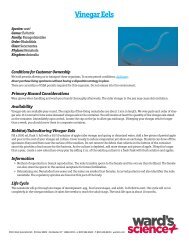WS_HSE_Catalog_VWR_new - Ward's Science
WS_HSE_Catalog_VWR_new - Ward's Science
WS_HSE_Catalog_VWR_new - Ward's Science
You also want an ePaper? Increase the reach of your titles
YUMPU automatically turns print PDFs into web optimized ePapers that Google loves.
iomedical technology | activities<br />
89<br />
Ward’s Karyotyping Human<br />
Chromosomes Lab Activity<br />
Safely Explore Actual Human Chromosomes<br />
Examining the banding patterns on chromosome spreads helps determine<br />
several factors in humans, such as a person’s sex, and any abnormalities that<br />
may be present, such as Down, Turner, and Klinefelter Syndromes. Ideal for<br />
advanced high school and college classes, students prepare, stain, and study<br />
an actual human chromosome spread to observe the banding patterns. For<br />
greater convenience, the human cells supplied in the activity come fixed at the<br />
metaphase stage. The cells are captured at a point of maximum contraction<br />
during mitosis, making the banding patterns clearly visible. The lab activity can<br />
be completed in two 45-minute lab sessions, and it comes with enough materials<br />
for six setups, a teacher’s guide, and student copymaster. An incubator,<br />
optional, is available separately. Note: Coupon included for perishable materials.<br />
Redeem by mail, fax, phone, or e-mail.<br />
366009 $191.00<br />
DNA Depot<br />
Simple, Student-Directed <strong>Science</strong> Activities<br />
• Designed to highlight fundamental science concepts<br />
without the use of expensive reagents and equipment<br />
• Students come away with a greater understanding of science,<br />
technology, and their role in society<br />
• All experiments are created and classroom tested by<br />
teachers and science education experts<br />
• Each kit includes an experiment guide with background<br />
information, procedures, safety recommendations, and<br />
an evaluation quiz<br />
Analysis and Comparison of<br />
Mamalian Cell Types Lab Activity<br />
Includes Cell Samples Safe for Classroom Use<br />
Differences between various mammalian cell types and how these cells function<br />
are revealed in detailed magnification with this activity. Cells are fixed on<br />
microscope slides, after which students stain the cells on the slide to view morphological<br />
characteristics of diverse cell types. The lab can be completed in 35<br />
minutes. Includes materials for six student groups, instructions, multispot slides,<br />
eosin and methylene blue stain, mounting media, cover slips, transfer pipets,<br />
and immersion troughs. A microscope with 400X magnification is required, but<br />
not included.<br />
368942 $118.15<br />
Blood Based<br />
Cancer<br />
Diagnosis<br />
Lab Activity<br />
Observe the Reaction<br />
of Cancer Cell Markers<br />
and Their Corresponding<br />
Antigens<br />
Cancer cells differ from normal<br />
cells by the combination<br />
of normal proteins that are<br />
present on their surfaces.<br />
Antibodies against these proteins<br />
will specifically bind to<br />
cancer cells, but not to normal<br />
cells. This characteristic<br />
allows for early detection of<br />
cancer and potentially a way<br />
of delivering cancer therapies.<br />
In this experiment, students<br />
view this process first-hand<br />
and understand the basis<br />
of cancer diagnosis. The lab<br />
takes 35 minutes to complete<br />
and materials for 10 student<br />
groups are provided. Includes<br />
instructions, microtiter plates,<br />
cancer cell markers, normal<br />
cell markers, transfer pipets,<br />
and buffer.<br />
368941 $70.00<br />
What is Cancer? Lab Activity<br />
A large number of cancers have been identified by association with the<br />
various parts of the human anatomy. In this experiment, fixed normal<br />
and cancer slides will be provided for students to conduct basic microscopy<br />
and determine the basic differences in cell structure. Emphasis is<br />
placed on skin cancer, which can easily be controlled by limiting exposure<br />
to sun. A basic microscope is required. Includes six slides.<br />
368920 $48.00<br />
ward’s<br />
science+





